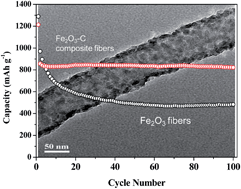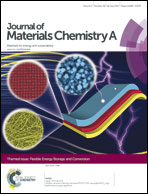Electrospun Fe2O3–carbon composite nanofibers as durable anode materials for lithium ion batteries†
Abstract
Combination of metal oxides and carbon has been a favourable practice for their applications in high-rate energy storage mesoscopic electrodes. We report quasi 1D Fe2O3–carbon composite nanofibers obtained by the electrospinning method, and evaluate them as anodes for Li ion batteries. In the half-cell configuration, the anode exhibits a reversible capacity of 820 mA h g−1 at a current rate of 0.2 C up to 100 cycles. At a higher current density of 5 C, the cells still exhibit a specific capacity of 262 mA h g−1. Compared to pure electrospun Fe2O3 nanofibers, the capacity retention of Fe2O3–C composite nanofiber electrodes is drastically improved. The good electrochemical performance is associated with the homogenous dispersed Fe2O3 nanocrystals on the carbon nanofiber support. Such a structure prevents the aggregation of active materials, maintains the structure integrity and thus enhances the electronic conductivity during lithium insertion and extraction.

- This article is part of the themed collection: Flexible energy storage and conversion

 Please wait while we load your content...
Please wait while we load your content...